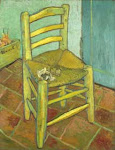-Vincent-van-Gogh-Met.jpg)
"I've already had an opportunity to find out what this mistral's like too. I've been out on several hikes round about here, but the wind always made it impossible to do anything. The sky was a hard blue with a great bright sun that melted just about all the snow -- but the wind was so cold and dry it gave you goose-pimples." -Vincent to Theo, 9 March 1888, writing from Arles
It came in the middle of the night. BANG! I sat up with a start in my room on the top floor of a hotel in Arles, then scurried to the window to secure the shutters. Oh yes, it was...
The MISTRAL!
I was very excited. Unlike many visitors, who'd rather not have their Provence vacations disrupted by a cold northwest wind, I was eager to feel the mistral for myself, because I was writing about it in "Sunflowers." While in Arles, Vincent hated the mistral, because it made it difficult to paint outdoors. By summertime he had concocted a solution, as he explains to painter friend Émile Bernard in a letter from June 1888: "My easel was fixed in the ground with iron pegs, a method that I recommend to you. You shove the feet of the easel in and then you push a 50-centimeter-long iron peg in beside them. You tie everything together with ropes; that way you can work in the wind." Even so, he had plenty of complaints, calling the mistral "a very nasty, nagging wind" (letter to sister Wilhemina, 31 July), "the devil" (letter to Theo, 18 August), and any number of other adjectives...aggravating, pitiless, violent. The mistral is mentioned many times in the Arles letters. Although there was mistral in Saint-Rémy as well, Vincent had fewer problems there. "The mistral (since there are a few mountains here) appears far less annoying than in Arles, where you always get it at first hand" (letter to Theo, ca 6 June 1889).
There is plenty of wind-lore in Provence: the climate is governed by winds, and every wind from every direction has its own name in the Provençal language. Folks in Vincent's day believed the mistral could bring about a nervous condition or at least headaches. I began to understand that during my trip: the mistral blew for three days straight, and the novelty quickly wore off. It whips through the plains around Arles with great strength, and it is COLD, blowing as it does from faraway mountains. The city itself seems designed to fend off the mistral, as the old medieval streets wind and turn and never go completely straight. This does help. But once you get by the river and into the open...brrrr.
The mistral was still going strong the day I went to Saint-Rémy. As I walked around the asylum and through the ruins of the Roman town of Glanum, I noticed the wind felt different than in Arles. There at the foot of the Alpilles, with the mountains to partly block the mistral (as Vincent observed), the wind was ... swirly. You couldn't tell what direction it was coming from. It was almost dancing.
I thought immediately of the painting seen here, "Wheatfield with Cypresses" (Met. Museum, image from Wikimedia Commons, click to enlarge), done in June 1889 while Vincent was staying at the asylum. The Saint-Rémy paintings are filled with swirly skies (think "Starry Night" from the same month), and many have suggested it says something about Vincent's mental condition. No, it doesn't. He was painting the wind! Notice how the wheat bends one way, the bushes another. Only the mountains and the cypresses barely move. Farmers in Provence still plant cypresses in strategic rows to buffer their fields from the mistral's force. Although the cypress can also be a symbol of death (and is often interpreted as such in Vincent's pictures), it's equally a symbol of strength, of protection. And those lavender mountains? The Alpilles are bare limestone peaks that pick up the colors of the clouds and sky. The day I visited Saint-Rémy, they were almost purple. Vincent certainly changed what he saw to suit his vision for the picture, but there's more "reality" here than meets the eye. It took a trip to Provence and a firsthand experience of mistral for me to understand that.






1 comment:
Great post, and great blog! Thanks for sharing.
Tina
Post a Comment